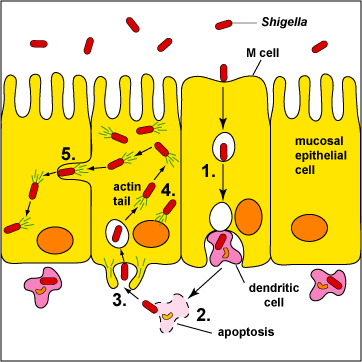5.3: The Ability to Invade Host Cells
- Page ID
- 3162
Briefly describe the mechanism by which invasins enable certain bacteria to enter host cells and state how this can promote colonization Briefly describe how a type 3 secretion system might be used to invade and survive inside host cells. State how certain pathogenic spirochetes such as Treponema pallidum and Borrelia bergdorferi use adhesins, invasins and motility to penetrate host cells.
Highlighted Bacterium
- Read the description of Shigella and match the bacterium with the description of the organism and the infection it causes.
- Read the description of Salmonella and match the bacterium with the description of the organism and the infection it causes.
- Read the description of Borrelia bergdorferi and match the bacterium with the description of the organism and the infection it causes.
Some bacteria produce molecules called invasins that activate the host cell's cytoskeletal machinery enabling bacterial entry into the cell by phagocytosis. Advantages of entering a human cell include (1) providing the bacterium with a ready supply of nutrients and (2) protecting the bacteria from complement, antibodies, and other body defense molecules.

When these bacteria contact the epithelial cells of the colon, the type III secretion system delivers proteins into the epithelial cells enabling them to polymerize and depolymerize actin filaments. This cytoskeletal rearrangement is a key part of the pseudopod formation in phagocytic cells and is what enables phagocytes to engulf bacteria and place them in a vacuole. Thus the bacterium with its invasins is able to trick the epithelial cell into behaving like a phagocyte and engulfing the bacterium. The bacteria then replicate within the host cell.
We will now look at several examples of bacteria that use invasions to invade host cells.

In addition, Shigella can induce the host cells to produce signaling molecules that attract phagocytic, antigen-presenting dendritic cells to the area. It enters the dendritic cells and uses them to carry the Shigella through the intestinal wall to the underside. It then uses its type 3 secretion system to inject effector proteins from the phagosome into the cytoplasm. These proteins trigger apoptosis or cell suicide of the dendritic cell. Killing the dendritic cells prevents them from presenting Shigella to T4-lymphocytes, a step required for the production of antibodies against the Shigella (see Figure \(\PageIndex{4}\)).
- For a movie showing Shigella being propelled by actin-based motility within a cell, see the Theriot Lab Website at Stanford University Medical School. Click on "Greatest Hits" and then on "Shigella flexneri associated with actin tails in PtK2 cells."
2. Salmonella use a type 3 secretion system to inject intestinal epithelial cells with effector proteins that stimulate actin re-arrangement and cause the epithelial cell's cytoplasmic to "ruffle" up and engulf the bacteria Figs. 5A - Figure \(\PageIndex{5}\)B. The Salmonella pass through the epithelial cell where they are engulfed by phagocytic macrophages.
Once in the phagosome of the macrophage the bacterium uses its type 3 secretion system to inject proteins that prevent the lysosomes from fusing with the phagosomes, thus providing a safe haven for Salmonella replication within the phagosome and protecting the bacteria from antibodies and other defense elements (see Figs. 5C-5D).
By injecting flagellin into the cytoplasm of the macrophage the Salmonella can also eventually kill the macrophage by inducing apoptosis, a programmed cell suicide.
Molecules injected into the intestinal epithelial cells also stimulate diarrhea. Advantages of inducing diarrhea include (1) flushing out normal flora bacteria so there is less competition for nutrients; and (2) better enabling Salmonella that are not attached to host cells to be transmitted to a new host via the fecal-oral route.
For a movie showing Salmonella invading a human cell, see the Theriot Lab Website at Stanford University Medical School. Click on"Greatest Hits" and then on "Salmonella typhimurium invading a fibroblast cell."
3. Listeria monocytogenes is another bacterium that enters intestinal cells via invasins and spreads to adjacent cells by actin-based motility. Its actin-based motility enables it to moves approximately 1.5 µm per second within the host cell.
For movies showing Listeria entering host cells and being propelled by actin-based motility within a cell, see the Theriot Lab Website at Stanford University Medical School. Click on "Greatest Hits" and then on "Life history of a single infecting Listeria monocytogenes" and "Listeria monocytogenes moving in PtK2 cells."
4. Although enteroinvasive Escherichia coli (EIEC) don't have actin-based motility, they invade and kill epithelial cells of the colon in a manner similar to Shigella.
5. Legionella pneumophila, after being ingested by macrophages and placed in a phagosome, uses a type 4 secretion system to inject effector proteins that prevent the lysosomes from fusing with the phagosomes and turning the macrophage into a safe haven for bacterial replication. The same mechanism allows the Legionella to survive inside amoebas in nature. These amoebas serve as a reservoir for the bacterium in the environment.
6. F protein and M-protein of Streptococcus pyogenes (Group A beta streptococci) enables the bacterium to invade epithelial cells. This is thought to help maintain persistent streptococcal infections and enable the bacterium to spread to deeper tissues.
7. The spirochete Borrelia bergdorferi probably uses a combination of invasins and motility to penetrate host cells. In this case the host cell doesn't phagocytose the bacterium. Instead, one tip of the spirochete attaches to the host cell and some form of invasin apparently causes the host cell to release digestive enzymes that enable the spirochete with its corkscrewing motility to penetrate the host cell membrane. Once in the host cell the bacteria may remain dormant for years and hide from the immune system and antibiotics.
8. Another spirochete, Treponema pallidum, is thought to enter cells in a similar fashion. Motility also helps B. bergdorferi and T. pallidum to invade and leave blood vessels by passing between and through endothelial cells, thus enabling the spirochetes to disseminate to other locations in the body.


